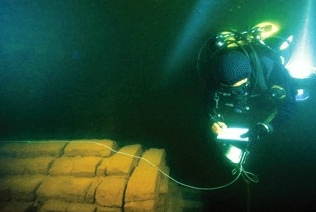(Ecns.cn)--Sleeping silently since 1959 under the man-made Qiandao Lake in the new Chun'an County of Zhejiang Province, two ancient cities from the Tang Dynasty called Hecheng and Shicheng have once again captured public attention.
The two cities were photographed by Chinese National Geography, a monthly magazine similar to National Geographic Magazine, and were listed as provincial protected historic sites by Zhejiang Province earlier this year.
1000 years of history
In 1955, the locations of the two cities were chosen for the largest hydraulic power plant in eastern China– the Xinanjiang hydraulic power plant. 290,000 people from both cities were then relocated to the new Chun'an County.
After thousands of years of history, both cities fell silent, soon to be submerged beneath the power plant's reservoirs.
Hecheng, also known as old Chun'an County, was built in 208 A.D., and served as a business hub in Zhejiang, while Sui'an County, built in 621 A.D., got the nickname of Shicheng because it sat against Wushi Mountain.
In ancient times the two places were significant hubs for water transportation and land traffic, and were considered vital centers of military importance. Both contained a myriad of old temples, memorial archways, bridges and other heritage buildings.
Well-preserved underwater
For many antiquities experts, the inundation of the two cities was cause for celebration. Generally speaking, before building up a reservoir it is necessary to "clean up" a place, meaning buildings must be bulldozed, trash cleared away and historic relics moved out.
But, according to local records, the governments of the two cities required a "preparation for inundation" which Hecheng mostly completed, but Shicheng abandoned due to a lack of time.
Shicheng was located further away from the future dam, so people did not expect the water to come as soon. Because there was no time to move furniture and other things, Shicheng was left more intact.
Beams, roofs and walls of the city were thus preserved underwater, and some courtyards are also in excellent condition, according to divers from the magazine.
Must be developed properly
Several years ago, the department of tourism at Qiandao Lake began planning a new attraction around the man-made scenery of the lake and the ancient underwater cities.
But development plans have been denied due to high costs and high risk, igniting discussion on how to exploit and develop the underwater cities without damaging them.
The area around Qiandao Lake is not alone in its ambitions. During the 1950s and 1960s, many local counties built reservoirs leaving old cities submerged, said Yan Guotai, a professor at Tongji University.
Developing the underwater cities is significant, but it needs to be carried out properly, added Yan.
"It does not necessarily mean that you should bring all the tourists underwater. High technology like underwater probes and holograms can also be used to let people see the underwater world," said Yan.
Underwater historic relics are a specialty, and protecting them should be the first priority, stressed Yan.


















